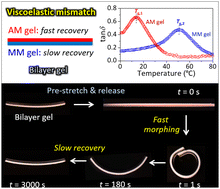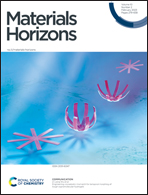Engineering viscoelastic mismatch for temporal morphing of tough supramolecular hydrogels†
Abstract
Viscoelasticity is a generic characteristic of soft biotissues and polymeric materials, endowing them with unique time- and rate-dependent properties. Here, by spatiotemporally tailoring the viscoelasticity in tough supramolecular hydrogels, we demonstrate reprogrammable morphing of the gels based on differential viscoelastic recovery processes that lead to internal strain mismatch. The spatial heterogeneity of viscoelasticity is encoded through integrating dissimilar hydrogels or by site-specific treatment of a singular hydrogel. The temporal morphing behavior of tough gels, including a fast deformation process and then a slow shape-recovery process, is related to the kinetics of associative interactions and the entropic elasticity of supramolecular networks after pre-stretching and release, which takes place spontaneously in the absence of external stimuli. Such a kinetically driven morphing mechanism resolves the trade-off between the mechanical robustness and shape-changing speed in tough hydrogels with dense entanglements and physical associations, and should be applicable to other viscoelastic materials. A numerical theory for the temporal morphing of tough supramolecular gels has been formulated by dynamic coupling of viscoelastic recovery and mechanics of deformations, which is further implemented to predict the sophisticated morphed structures. Furthermore, magnetic particles are incorporated into the morphed tough hydrogels to devise versatile soft actuators and robots for specific applications.



 Please wait while we load your content...
Please wait while we load your content...